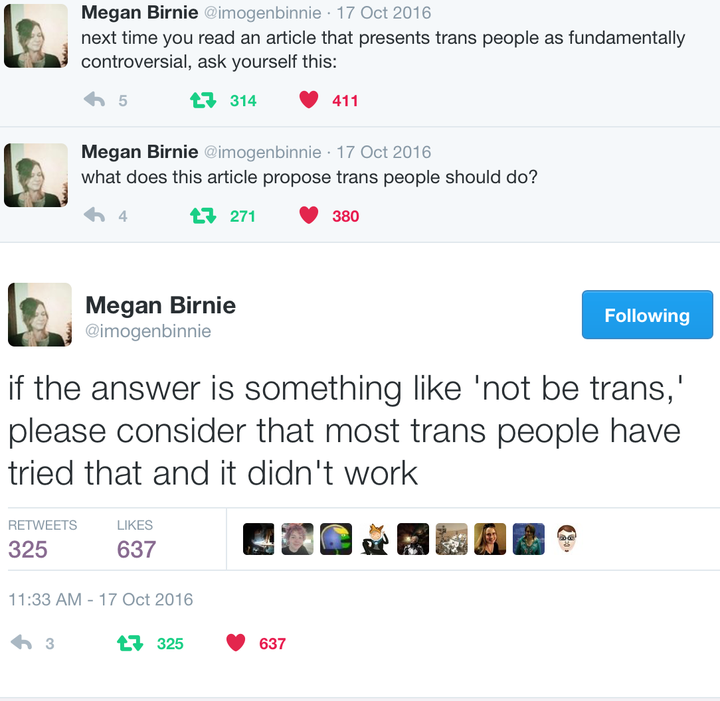
Over a few years, access to bathrooms has become a wedge issue. Bathroom bills hurt trans and cis people alike.
Public opinion on bathroom bills is mixed at best. When people are asked if they support laws that force trans people to use the wrong bathroom, most people say no. But when asked about whether birth certificates should decide who uses which bathroom, most people say yes. It’s likely that the vast majority of people don’t even realize these answers are contradictory. Talking to people, one gets the distinct impression that most have never thought about how we decide who gets to use which bathroom and most don’t want to have to think about it!
Unfortunately, we don’t have that option. Bathroom bills have become the new wedge issue, meaning that we’ll be litigating these questions in the court of public opinion until a clear majority emerges. Trans people are such a small minority that the opinion of cis people (people who aren’t trans) will overwhelmingly decide these issues. So, I’m writing this essay specifically for the cis people of the world. The people who probably have given little thought to how we gender each other and who might be surprised or even annoyed that this is now a major topic of conversation on which everyone is expected to take sides. I want to talk about why cis people should care about bathroom bills and how these decisions affect everyone.
In practice, these bills are all attempts to regulate the ways that we gender each other, specifically how we decide who gets to go into female-specific and male-specific spaces. There are two main ways we do this:
Assigned sex: This is the sex (and gender) most people are given at birth. You know the drill: boys come from Mars and wear blue and have one kind of parts while girls come from Venus and wear pink and have the other kind of parts. (more here)
Gender identity: This is the gender that someone exists in the world as. What does a person write in the “gender” box on forms? Which gendered spaces do they use? Most importantly, what gender do they say they are? This one might seem new. (more here)
I suspect that most cis people are unfamiliar with this distinction. That’s okay! So was I for a long time. But stay with me for a moment because it’s important.
The status quo
Today in the United States, we have many spaces that are meant to include only one gender (either male or female). I’ll call these gendered spaces. Examples include the “men’s room”, the WNBA, Curves, and the Catholic Priesthood. Gendered spaces have a long and fascinating history.

Charlotte Cooper was one of 22 women to compete in the 1900 Olympics.
Take a moment and think about how access to these spaces has historically been determined. Specifically, let’s imagine we watched the 1900 Olympics where women were first allowed to compete. 22 women competed across five events. How do you think it was determined that these 22 people would be allowed into the gendered spaces meant only for women? Given the choice above, between assigned sex and gender identity, you might be tempted to choose assigned sex. But how do you image they might have determined assigned sex in 1900?
One common notion is that we can learn a person’s assigned sex from their chromosomes, specifically allosomes like X and Y. The idea is that when a doctor says, “it’s a boy,” we learn not only about that child’s genitals but also their chromosomes. If this is true, then later in life, we might be able to read a person’s chromosomes to determine their assigned sex. However, the idea that allosomes determine sex didn’t exist until a year after the 1900 Olympics.
If chromosomes don’t work, another common answer is that birth certificates could have been used. These are literally a record of the assigned sex. But the US didn’t begin to standardize birth certificates until 1902 and it took until 1930 to fully standardize the system (other countries are similar). Without a standard system for recording, storing, and verifying birth records, birth certificates provide a shaky insight into assigned sex.
The last answer I often hear is that we didn’t need a method because it was obvious then; women were women and men were men. But nothing could be further from the truth. The Olympics have had trouble gendering athletes as long as the Olympics have included and separated the two sexes. Some of the female competitors didn’t appear stereotypically feminine, and competing nations quickly called the gender of these women into question. The ‘solution’ for the Olympic games was a century long series of humiliating, unscientific, and unsuccessful “sex tests”. Over the years, these “sex tests” inaccurately flagged several women while never finding a single incident of a male falsely competing as female in order to gain an advantage.
In truth, access to gendered spaces has historically been determined primarily by gender identity. In general, people who identify as male are simply treated as male and people who identify as female are simply treated as female. In most cases this process has gone smoothly, so smoothly that most people have never had to even think about it. In a world with no karyotyping and unreliable birth certificates, gender identity is literally the only practical criteria we have for separating gendered spaces.
This system is not without problems, though. For one, people have been seeking to measure gender identity for a very long time and no one has yet found a solution. Simply asking people might seem too trivial. Wouldn’t the Russians then be able to win all the women’s gold medals by having men say that they’re women? Can we ‘objectively’ measure gender identity? And what happens when the way we determine gender identity violates our assumptions? These answers have yet to be answered in a way that all, or even most people, find satisfactory. We’ve managed to ignore these problems except in a few cases, such as the Olympics. But where problems with using gender identity occurred, no practical alternative has ever been offered.
Modern problems with assigned sex
Earlier I explained how assigned sex has historically been an impractical method for separating gendered spaces. But what about now? In practical terms, little has changed.
In general, many problems with using assigned sex come from the fact that assigned sex is far messier than many people (cis or trans) realize. Compare the difficulty of determining someone’s gender identity with the difficulty of determining someone’s assigned sex. For nearly everyone, cis or trans, gender identity is outwardly visible and manifestly obvious ― in gendered spaces, people simply choose the option that best matches their gender identity (modulo concerns such as safety). Assigned sex on the other hand is a detective’s game. We have to look for clues, DNA evidence and government records, and none of these are perfect. We can look for hints from outward appearances but these often lead us astray.
Several bills have been proposed to separate gendered spaces according to assigned sex but none of them offer a workable solution. One option uses birth certificates, with people who have an M going to the men’s room and people who have an F going to the women’s. This might seem cut and dry but we run into an analogous set of problems. Such a system erases intersex people for whom assigned sex is often inaccurate or worse. Even if we completely ignore intersex people, this system is impractical. A birth certificate is a piece of paper that can be lost, updated, amended, or made in error and some people don’t have a birth certificate at all. People who do have a birth certificate aren’t expected to carry it on their person at all times. For these and other reasons, the only state that has passed a law that uses birth certificates to determine access to gendered spaces found this to be unenforceable in practice.
The other proposal defines assigned sex according to the allosomes, with XX people using the women’s room and XY people using the men’s room. Except many people don’t fit into either of these groups and there’s no clear indication of what, for instance, XXX or XXY or any other combination should do. Not only that but we know that sex is not, in fact, determined by XX vs XY but instead by a complex interaction of genes that we’re only beginning to understand. Even ignoring these problems, karyotyping is expensive, takes weeks to do, and very few people have ever been karyotyped.
If a school suspects that a child is using the wrong bathroom, would they be required to order a $500 genetic test and who would pay for it? If so, what would the school do for the seven or more days while they’re waiting to hear back? And what would be done if the child has an unexpected allosome combination? Because resources are scarce, how would the school decide who to test and who not to? Would the policy be to only spend money testing students who don’t appear stereotypically female or male? If so, that’s a clear violation of Title IX.
These practical concerns apply to everyone. Schools that are required to implement a system based on assigned sex would have to divert funds to record or measure every student’s assigned sex. Schools would have to use resources to navigate the many unclear cases and several schools would need to defend those decisions in court. Troublemaker children will have a new tool for wasting time (does Mr. Smith have to take a leave of absence for the two weeks it takes see what chromosomes he has?) and harassing other students.
To date, there has been no system that uses assigned sex and avoids these problems.
The status quo for trans people
So far, I’ve talked a lot about how the ways we separate gendered spaces affect people in general, including cis people. Before wrapping up I want to shift gears to talk about how these matters affect trans people. This is crucial to understanding the full extent of the harm caused by bathroom bills.
Most people are cis, and for these people there is little difference between assigned sex and gender identity. Trans people are different. At some point in the life of a trans person, they become aware that their gender identity is different from their assigned sex. Most trans people, then, go through a process that aligns their experience with this identity (this is called a transition). This transition (more precisely other people’s perception of it) is the source of many problems for trans people.
Think about a common story. Imagine that Jesse was assigned male at birth and went through life as a boy in all the ways boys do ― sports teams, bathrooms, clothes, etc. Jesse had always felt more like a girl but was never bothered that much by life as a boy. However, while entering puberty at a public middle school, Jesse became distressed by the masculinization of her body and wished to transition to female. She then set out to do all the things that many trans girls do: clothes, therapist, hair, hormones, etc.
But in cases like these, the problems come from other people. Others around her observe as things about Jesse change including her apparent gender identity. To put it bluntly, at some point Jesse will use the women’s room where before she had used the men’s. These perceptions reveal the additional rules by which people determine gender identity. There are several of these unwritten rules including:
- Gender expression should match gender identity.
- Gender identity should not change.
- Privileged groups, especially races, have a greater license to bend rules.
Greater scrutiny is given to those who break any of these rules and in many cases, access to any gendered space can be revoked. By the very act of transitioning, Jesse is violating the first two of these unwritten rules and possibly the third. These rules bias the system in favor of binary trans people (those who fit gender stereotypes), stealth trans people (those who hide their identity), and white trans people. These rules have historically been enforced by the medical establishment who gave access to care disproportionately, or exclusively, to trans people who followed the rules.
These rules have meant that the families of trans children are expected to uproot, move to a new school and reintroduce their child with a new gender identity so that others did not see a child change their gender identity. They have meant that many trans adults have had to sever all ties with friends and family. The rules make the act of transitioning, of being between gender identities, an enormous personal risk. They mean that learning that someone has changed their gender identity has been used, successfully, as a legal defense for murdering trans people. These rules mean that nearly half of trans people will be driven to suicide, and that the suicide rate is greater for trans people who break any of the rules. These rules have created an epidemic of murders of trans women of color.
The unwritten rules mean that any trans person who decides to transition does so at great cost. When a trans person transitions, they undermine their gender identity in the eyes of others. They make themselves vulnerable and the outcome is often fatal. No one does this lightly.
How using assigned sex hurts trans people

Famous and popular writer, Imogen Binnie.
Beyond the practical concerns that affect everyone, separating bathrooms according to assigned sex is extraordinarily cruel to trans and intersex people.
When trans people decide to transition, they do so within a system that already severely punishes trans people just for being trans. Under any system that uses assigned sex, trans people are harmed even further. These regulations take people who have chosen what’s best for themselves in a difficult situation and then forces those people to go back to a worse option. It takes trans people who chose to transition under the status quo and it forces them to either navigate gendered spaces as the wrong gender or avoid public life altogether. This literally kills trans people.
The use of assigned sex has a tremendous negative effect on trans people that cannot be overstated. It also harms everyone more generally. In the classroom, using assigned sex means that any student whose assigned sex doesn’t match their gender identity must use gendered spaces that are clearly wrong for them. The use of assigned sex has already forced trans boys to compete against girls in female sports. This situation is bad for trans boys and it also harms cis girls who are not given a fair competition. More jarringly, using assigned sex would actually force trans girls into boy’s locker rooms. Such a situation is maximally unsafe for trans girls and it is deeply disruptive to any school.
The way forward
With all this in mind, I want to visit one last proposal for separating gendered spaces: protecting gender identity. Such a system functions as a modification of the status quo: essentially, it codifies the historical practice of using gender identity but removes the unwritten rules. These unwritten rules would be clearly illegal anyway because they violate protections against discrimination on the basis of race and sex.
Laws that protect gender identity have numerous benefits that are shared by everyone. We all benefit from the fact that this is imminently practical. The gender identity of people could not be more clear: we can simply ask them. Schools would be required to spend zero dollars in order to accommodate such a law. Bathroom bills that use assigned sex would force trans people into the wrong gendered spaces, leading to problems such as boys competing against girls in female-specific sports. But protecting gender identity ensures that, whatever else, this will not happen. If one is concerned about “boys in girls locker rooms” then protecting gender identity is actually the only viable option.
I truly believe that most cis people do not wish trans people harm. Protecting gender identity is the only option that actually reduces the burden for trans students. This policy would make it a little bit easier for families of trans students to remain in place instead of uprooting and moving in order to hide a transition. People of all races would be equally protected under such a law. And, in at least one small way, trans people that do not adhere to gender stereotypes would be less singled out.
Trans people never asked to be made the center of a nationwide policy fight. But now that we are, communication with the majority of people who are not trans is an essential tool. When we take a practical, realistic approach to questions of gendered spaces it becomes clear that using and protecting gender identity is a policy that benefits everyone. It’s practical, compassionate, and keeps the government out of the messy process of determining sex and gender.
